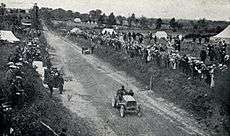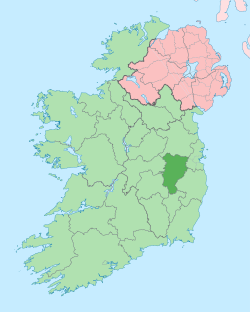Calverstown
Calverstown (Irish: Baile an Chalbhaigh)[2] is a small village in County Kildare, Ireland. It lies 6 km (3.7 mi) south of the town of Kilcullen and about 16 km (9.9 mi) from each of the towns of Athy, Kildare, Naas and Newbridge. It is an old settlement located close to the archaeological sites of Dún Ailinne and Old Kilcullen. The village has a stream running through it with another to the south. As of the 2016 census, Calverstown had a population of 699.[1]
Calverstown Baile an Chalbhaigh | |
|---|---|
Town | |
 Calverstown Location in Ireland | |
| Coordinates: 53°04′57″N 6°47′53″W | |
| Country | Ireland |
| Province | Leinster |
| County | County Kildare |
| Elevation | 106 m (348 ft) |
| Population (2016)[1] | 699 |
| Time zone | UTC+0 (WET) |
| • Summer (DST) | UTC-1 (IST (WEST)) |
| Irish Grid Reference | N802041 |
History
_(geograph_2495107).jpg)
Calverstown has been in existence as a named location since the early medieval period. An early reference to lands described as "Terra Philippi Vituli" (Latin for "Philip of Calves land") provides an unaudited confirmation in the form of a petition from the Royal Hospitallers of Kilmainham listing their possessions to Pope Innocent III in 1212. The Irish name Baile an Chalbhaigh was historically anglicised as Ballinchalwey, Ballinchallowe and Ballinchalloe.[3]
In a note to an edition of Richard de Ledrede's account of the Kyteler witchcraft trial, Wright (1843, p.56-7) noted that Walter le Veele, or Calf, of Calfstown was Chancellor of Kildare Cathedral and was made Bishop of Kildare in 1299. He purchased the manor of Norragh, in which Calverstown is situated, from Geoffrey de Norragh before his death in 1332. The barony was inherited by his nephew John Calf, who passed it to his son Sir Robert Calf and to his daughter Elizabeth Calf who married William Wellesley of Baronsrath, whose heirs held the barony after that. The name of the town appears to be derived from the anglicised name of the le Veele family.
It is explicitly mentioned in a Rental of Gerald Earl of Kildare begun in 1518-19 1518 as "In baronia de Norragh. Item, in the barone of the Norragh & may be distraynet at Calfiston: £6" (MacNiocaill 1992, 291); and in the Extents of Irish Monastic Possessions 1540-41. In the former, the name is spelled Calfiston, in the latter Calveston.
The Civil Survey of 1656 noted that in 1641 Calverstown contained 760 Irish acres of land and had one castle and a stone quarry and was held by Sir Robert Dixon (Simington 1952, 98)
The population, street layout and land-use have changed little over the past two and-a-half centuries. A map from 1752 shows a layout very similar to that of today. The natural environment reflects the predominance of well-established enclosed agricultural land.
The ruins of Calverstown Castle (an early 17th century manor house incorporating an earlier tower house) is located to the south of the village in the demesne of the later (18th century) Calverstown House.[4]
Battles at Ballyshannon and Kilrush
Two battles were fought nearby. In 738 at the Battle of Uchbad (Ballyshannon, Grid reference N78830), Aed Allin defeated the Laigin and established Kildare’s hegemony over the kingship of Leinster that would last nearly 300 years.[5] In 1642, James Butler, Earl of Ormond defeated his second cousin Richard Butler, Lord Mountgarrett, on the high grounds of Kilrush and Bullhill, a victory was considered so important that the English House of Commons voted him £500 for the purchase of a jewel, and petitioned the King to create him a Knight of the Garter. The site has since then been known as Battlemount (Grid reference S 77276). Guillaume le Maréchal (or William Marshall), Earl of Pembroke and son in law of Strongbow, founded an Augustinian Abbey in Kilrush at the start of the thirteenth century which subsisted until the Suppression of the Monasteries in the 1540s.[6]
Birth of motor racing

On Thursday, 2 July 1903 the Gordon Bennett Cup started at the Ballyshannon cross-roads 1 mile (2 km) from the centre of Calverstown. It was the first international motor race to be held in Great Britain. The Automobile Club of Great Britain and Ireland wanted the race to be hosted in the British Isles, and Ireland was suggested as the venue because racing was illegal on British public roads. After some lobbying, several local laws were adjusted and Kildare was chosen as the location – at least partly because the straightness of the roads was seen as a safety benefit. As a compliment to Ireland the British team chose to race in Shamrock green[Note 1] which thus became known as British racing green.[7][8][9][10] The route consisted of several loops of a circuit that passed through Kilcullen, Kildare, Monasterevin, Stradbally, Athy, Castledermot, and Carlow. The race started at the Ballyshannon cross-roads (53.0853°N 6.82°W) near Calverstown on the contemporary N78. The 328 miles (528 km) race was ultimately won by the Belgian racer Camille Jenatzy, driving a Mercedes.[11][8]
Developments and community
Housing developments in Calverstown include Lee Drive, Grove Villa, Rose Cottage, Blackhall Castle and the Forge. There is a green in the centre of the village with seating by the stream.
Local organisations include a Tidy Towns committee, a golf society and several residents associations.
There is a pub, previously called 'Hickey's for many years, but in recent years the name was changed to "The Stream Inn". A shop is located beside the pub, owned by local man John McCann, with a takeaway also inside the shop.
Notable people
- Ruby Walsh, national hunt jockey, lives in Calverstown with his family.
Further reading
- Dick, William; Vanda Clayton; Rebecca Jeffrey (1999). Calverstown, A baseline review for Calverstown Tidy Towns. Blessington Co. Wicklow, Ireland: duQuesne Environmental Limited.
- MacNiocaill, G. (1992). Crown Surveys of Lands 1540-41 With the Kildare Rental Begun in 1518. Dublin: Irish Manuscripts Commission.
- Simington, R.C. (1952). Civil Survey Co. Kildare. Dublin: Irish Manuscripts Commission.
- Wright, T. (1843). A Contemporary Narrative of the Proceedings Against Dame Alice Kyteler Prosecuted for Sorcery in 1334 by Richard De Ledrede, Bishop Of Ossory. London: The Camden Society.
Notes
- According to Leinster Leader, Saturday, 11 April 1903, Britain had to choose a different colour to its usual national colours of red, white and blue, as these had already been taken by Italy, Germany and France respectively. It also stated red as the color for American cars in the 1903 Gordon Bennett Cup.
References
- "Sapmap Area - Settlements - Calverstown". Census 2016. CSO. April 2016. Retrieved 5 January 2020.
- "Baile an Chalbhaigh / Calverstown". logainm.ie. Irish Placenames Commission. Retrieved 5 January 2020.
- Placenames Database of Ireland (see archival records)
- "Calverstown House, Calverstown Demesne, County Kildare". buildingsofireland.ie. National Inventory of Architectural Heritage. Retrieved 5 January 2020.
- Journal of the Kildare Historical and Archaeological Society, Volume III pp425-452
- Journal of the Kildare Historical and Arhcaological Society, Volume XVII pp125-126
- Circle Genealogic and Historic Champanellois Archived 5 March 2007 at the Wayback Machine
- Leinster Leader, Saturday, 11 April 1903
- Forix 8W - Britain's first international motor race by Brendan Lynch, based on his Triumph of the Red Devil, the 1903 Irish Gordon Bennett Cup Race. 22 October 2003
- The Gordon Bennett races - the birth of international competition. Author Leif Snellman, Summer 2001
- Bleacher report, The Birth of British motor racing
